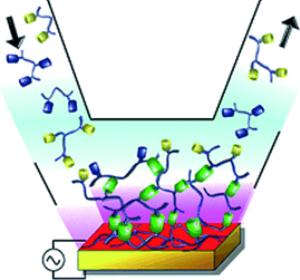
|
Polymers that 'click': A polymer film is obtained by the Cu(I)-catalyzed Sharpless click reaction between two polymers, bearing either azide or alkyne groups, both present simultaneously in a Cu(II) solution (see picture). The Cu(I) morphogen is generated at an electrode by applying an adequate potential. This concept can be extended to supramolecular films formed by coordination complexes.
[Credit: Angewandte Chemie International Edition] |
The growth of our bones, seashells, or the complicated forms of diatoms, requires the processes involved in biomineralization to occur along precisely controlled tracks. Molecules cannot simply be allowed to react in an uncontrolled fashion as soon as they encounter each other. In order for a complex organism to develop, every individual cell must know where it is located within a growing organ. Special signal molecules called morphogens inform the cell. They are formed in a specific location and then spread out into the surrounding tissue. This results in concentration gradients, which the cells can use to “orient” themselves.
Schaaf and his co-workers chose a similar strategy to form thin films on a substrate. They also used a sort of morphogen to steer the process. The reactants involved were polymers, one containing azide groups (–N3) and the other with alkyne groups (–C=CH) as side chains. In the presence of positively charged copper ions (CuI), these groups react with each other to form a carbon- and nitrogen-containing five-membered ring, crosslinking the polymers. This type of reaction is called “click chemistry”, because the reaction partners simply snap together.
In a solution containing both click partner and CuI ions, the reaction would immediately proceed at random. This would not result in a thin polymer film. The scientists’ idea was thus to place the Cu(I) ions as a morphogen only on the surface to be coated. Their approach was to place Cu(II) ions in the solution. They then applied an electric voltage to the surface. When Cu(II) ions come into contact with this surface, they take an electron to become Cu(I). These are thus primarily to be found on the surface. Where there are Cu(I) ions, the click reaction can proceed; the polymers only crosslink into a continuous film on the surface. The magnitude of the applied voltage can be used to control the number of Cu(I) ions and thus the thickness of the film.



